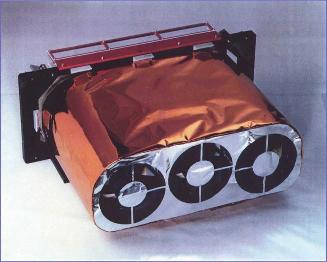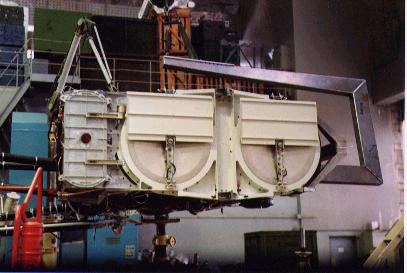The camera will be launched by an Indian satellite during 2006 * The camera will be used for the scientific study of distant galaxies and star formation

The camera will be launched into space on the Indian communication satellite "GSAT-4", the total investment in the development of the camera and its adaptation to the Indian satellite will amount to approximately 15 million dollars.
The TAUVEX camera is based on a camera developed during the nineties by Alup, for the Ministry of Science and Technology, in the scientific collaboration of Tel Aviv University.
This is a space electro-optical camera, for scientific use, consisting of three "telescopes" for observation in the "ultraviolet" field for astronomical research of the galaxies. The scientific research activities, based on the outputs produced by the camera, will be done jointly by the academic research institutions of the two countries.
The contract signed yesterday constitutes the implementation of the Memorandum of Understanding signed in December 2003, during the visit of the Minister of Science and Technology to India, between the Israel Space Agency (SLA) and the Indian Space Agency (ISRO, for scientific cooperation between the two countries for astronomical exploration of space in the field The "ultraviolet" radiation.
The Minister of Science and Technology Eliezer (Modi) Zandberg said: "Cooperation in the field of space with India is an important element in strengthening the strategic ties between Israel and India, which include cooperation in the fields of science, industry, agriculture and more." According to him, "India and Israel are countries with proven capability in the field of space that believe that space exploration is essential for advancing national and economic goals."
Haim Russo, CEO of ALUP, said: "Elbit Systems sees this contract as a very important step in strengthening cooperation with international parties on space issues for civil and scientific applications. These collaborations are made possible thanks to the efforts of the Israeli government, led by the Ministry of Science and Technology, in creating framework agreements with countries around the world."
background
Upon assuming the position of Minister of Science and Technology, Minister Zandberg brought up to the Prime Minister the scientific and technological value of launching the telescope. During his historic visit to India last September, Prime Minister Ariel Sharon pledged that Israel and India would implement the understandings agreed upon by the space agencies of the two countries, as part of the State of Israel's policy to strengthen its relations with India, including science and space ties. The 80s by three researchers from Tel Aviv University, Dr. Noah Brosh, Prof. Hagi Netzer and Prof. Elia Leibovich. The idea was to produce a set of three wide-angle telescopes that would provide an image of the ultraviolet (uv) radiation of the sky. In order to deal with important questions in the field of space exploration, including the structure of stars, the history of galaxies and the physics of large black holes (one of the most mysterious phenomena in the universe, these are huge concentrations of mass that create a tremendous gravitational force, any object, particle body or light beam that falls under the influence of this field is not can get rid of it).
The use of a telescope based on ultraviolet radiation allows observing very distant phenomena because the amount of noise at this frequency is lower than at visible light frequencies.
In 1991, the Israel Space Agency joined an international project, during which it was planned to build an SRG research satellite, and contributed to it the Towax project. The task of building the station was handed over to the Russian Space Agency, but the Russian Space Agency ran into budget difficulties and was unable to launch into space the components of the international research project, including the Israeli telescope.
The space agency ordered Al Op and researchers to find other launch opportunities. About three years ago, the Indian Space Agency expressed willingness to launch the TAWAX into space.
The contacts between Indian and Israeli scientists reached maturity as early as 2001, when it became clear that the launch of the Tawax on an Indian satellite of the GSAT-4 type was an opportunity to prove the capabilities of the Indian satellite and also to launch into space a very important scientific measuring device. However, until this year no financial sources were found to complete the project.
Despite the delays in launching it into space, the Towax project is considered one of the successful space projects initiated by Israel. The project paved the way for the local space industry, opened up business and technological relations with European countries and assisted in the acquisition of valuable knowledge in the field of designing space systems.
Tel Aviv University's TAUVEX telescope will be launched in 2005 from an Indian rocket, a decade late
According to the report, the Israeli Space Agency invested 15 million dollars in the construction of the telescope that will be launched on top of an Indian rocket. Designed to map new galaxies
19.9.2003
From: Haaretz news agencies, Walla news!
Direct link to this page: https://www.hayadan.org.il/israspace190903.html

The report stated that the Israeli Space Agency has so far spent 15 million dollars on the construction of the telescope, which is designed to map new galaxies. The newspaper quoted Israeli officials as saying that Israel intends to send the telescope into space on a rocket that India will send into space by the end of 2005. The information from the telescope will be for scientific purposes only, and both countries will use it.
Prime Minister Ariel Sharon said during his visit to India earlier this month that Israel decided to send the telescope into space on an Indian rocket. The details of the telescope launch were agreed a few months ago during the visit to Israel by the chairman of the Indian Space Research Organization.
The cooperation between Israel and India on the issue of space began about two and a half years ago with a meeting between scientists from the two countries in Austria, and was expanded in an agreement signed in India in October 2002. Israel and India apparently also agreed on a deal in the amount of one billion dollars for the sale of radar systems from the Israeli Air Force to India. During Prime Minister Sharon's visit to India, the countries signed six agreements to strengthen ties in education, health, culture, technology and the environment.
The Israeli telescope was built in 1993 as part of an international project to launch a large number of telescopes on a Russian satellite. The satellite, weighing 6.5 tons, was supposed to be launched in 1995. In total, about 15 million dollars were invested in the construction of the telescope.
Financial problems at the Russian space agency caused repeated postponements of the launch until in 2000 the European Space Agency rejected a request from the Russians to help it build its satellite, which caused the project to be dismantled. The Israel Space Agency has begun searching for an alternative collaborative project to launch the telescope into space.
The head of the Indian Space Agency visited Israel about a month ago, and during his visit we also discussed the cooperation regarding the launch of the telescope. During his visit to India about two weeks ago, Prime Minister Ariel Sharon stated the Israeli government's intention to support the project. Har-Evan clarifies that the Ministry of Science, which is responsible for the Israeli Space Agency, has not yet received the promised budget that would enable the adaptation of the telescope, which is stored in the Alup company's warehouses, to the Indian satellite, as well as the replacement of some systems that have become obsolete over the years.
An ultraviolet telescope is built like a normal telescope from an array of mirrors, but these are coated with a special material that reflects the ultraviolet rays.
Using this type of telescope it is possible to locate, among other things, gas clouds and young stars that emit ultraviolet radiation.
Milestones in the development of the telescope
*1993 The Israeli company Alup begins building the telescope.
*1995 The planned launch of the Russian satellite that was supposed to carry the telescope was cancelled.
*2000 The European Space Agency rejects the Russians' request to support the project.
*2001 First meeting between representatives of the Israeli Space Agency and the Indian Agency.
*August 2003 The head of the Indian Space Agency arrives in Israel.
*September 2003 the Prime Minister announces that the government has budgeted a special sum of money for the launch of the telescope.
